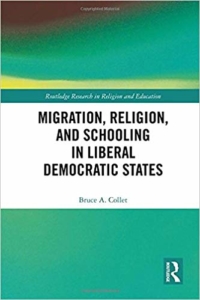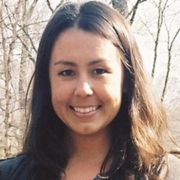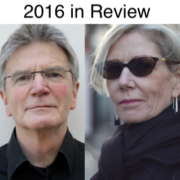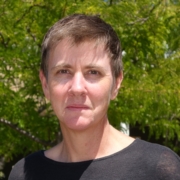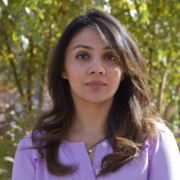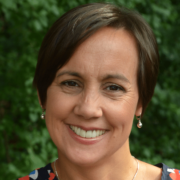The images and stories of migrant families being separated by the United States government set off a global conversation about immigration, borders, and justice. If the political philosophy of liberalism is based on liberty and equality, then the events of the past few months have challenged the very core of liberal democratic states.
My guest today is Bruce Collet. He researches migration and public schooling, with a special interest in migration, religion, and schooling in democratic states. He’s thinking through what we might call liberal multiculturalism as well as issues around security.
Bruce Collet is a Professor in Educational Foundations and Inquiry at Bowling Green State University in Ohio. He is the author of Migration, Religion, and Schooling in Liberal Democratic States (Routledge, 2018), and Editor of the journal Diaspora, Indigenous, and Minority Education.
Citation: Collet, Bruce, interview with Will Brehm, FreshEd, 121, Podcast audio, July 2, 2018. https://www.freshedpodcast.com/brucecollet/
Transcript, translation, and resources:
Will Brehm 1:42
Bruce Collet, welcome to FreshEd.
Bruce Collet 1:44
Thank you very much. Thank you for having me.
Will Brehm 1:47
Can you describe the state of migration around the world today?
Bruce Collet 1:51
Yes. Well, as you know, we are in a in a period of what seems to be almost unprecedented global migration. As of last year, 2017, about 3.4% of the world’s population were actually international migrants. That’s about 258 million people. So that’s a heck of a lot of people. You know, we have seen, of course, massive migration before in the post World War Two period. But a lot of observers, in fact, are drawing a comparison between the post World War Two period and the present period of the exodus from Syria and Maghreb region. So the certainly a lot of people are on the move. We can certainly talk about the differentiating between immigrants, you known, voluntary migrants and forced migrants, or refugees, because they do go to different parts of the world. I might add, just because it’s so essential to the book, there’s an overall pattern of movement from the global South to the global North, when we think about global South and North and in development terms. And if you juxtapose that with a kind of like a world map of religiosity, you’ll find that the global South tends to be more religious than the global North. And in fact, the Pew Research Center a few years back did a very interesting study called “faith on the move.” And they found that about 91% of our international migrants are in fact, religiously affiliated. So global migration is, it’s there, it’s intense, but it’s also fairly religious. And that certainly was part of the background or motivating factor for writing the book.
Will Brehm 3:37
And so what happens when this heavily religious group of people from the global South migrate, either by force or by free will, migrate to the global North, which as you’re saying less religious, maybe more secular in a way? You know, what I actually happens inside some of these countries in the global North?
Bruce Collet 4:06
I guess I have to ask you what you mean by what happens. I think we’re experiencing — I mean, I’ll probably keep most of my thoughts to the book itself, which really concerns public schooling because there’s so many different spheres of society that you could look at in terms of what’s going on, what happens. And I want to add a couple of important qualifiers here. I mean, you know, we’re saying broadly, that most of our migrants are coming from the global South. That’s in broad brushstroke terms. Of course, we have, migrants from global North as well. And, and not all of them are highly religious, you know. China, for example, is one of the top five sending countries to the US, but only about 7% of the Chinese population actually feel religious or, you know, would report any sense of religiosity. So, I do want to qualify those things. But in terms of in terms of schooling, what happens is,it really varies from country to country. There are some schools that are well versed and very well practiced in welcoming new new migrants — immigrants and refugees — and they’ve gotten to know the train pretty well. And they’ve learned how to recognize and accommodate various faith traditions, that is amongst their children who happened to be religious at all. I’m not assuming that migrant children necessarily are religious, but for those who are, some have gotten it down pretty well. And they have, I think, pretty well developed policies of recognition and accommodation. Others, not so much; others are really scrambling and trying to figure out how to accommodate, how to recognize; or if they want to recognize or to what degree shall they recognize and accommodate. So those are all questions that kind of forum this question about what happens at the school level.
Will Brehm 6:03
You’ve been actually looking at these migration patterns and the issue of migration inside liberal democratic states. What do you mean by a liberal democratic state?
Bruce Collet 6:16
I think of a liberal democratic state, because basically a state that has a representative democracy and has elected representatives; is defined by certain constitutionally provided rights and freedoms such as due process, privacy, property, equality before the law, freedoms of speech, freedom of assembly, and very importantly, I think, for this work, freedom of religion, particularly free exercise. And then also freedom from establishment of religion, that is that they’re free to practice, but they’re also free to go to places like public schools without having a kind of a state religion forced upon them. But if we get into the questions about secularism there are variations: there’s degrees regarding these matters, like to what degree they accommodates religious students, or to what degree they recognize them. There’s not just one one answer for that. But that’s that’s basically how I’m understanding liberal democratic state. It so happens in this book that I pretty much only write about Western democracies. So the reason why I do that is because I’m focusing on immigrant receiving societies, because there are some democracies of course in the world that aren’t really large immigrant receiving societies. So yeah, so there are, you know, I had to, I had to kind of limit my, the range of my study in that way.
Will Brehm 7:37
So what are these different degrees that you have identified in terms of liberal democratic states receiving immigrants and the way in which they accommodate this the religious freedom inside schools. So, you know, what would be an extreme case — or maybe either extreme of really embracing religious diversity inside schools without mandating a national religion, but then on the other extreme, countries that don’t really allow religious practice inside institutions like schools?
Bruce Collet 8:18 There are multiple secularisms. There’s not just one secularism there’s many ways in which different countries are taking up or democracies are taking up secularism. And I think that the very commonly used example on one end is is France with its — what can we say — rather sterile form of secularism or kind of hard secularism. France, as many of your listeners may may know, has a policy of not allowing any sign of religion — religious wear, religious garb, religious symbols, at least outwardly displaying on clothing, stems from a 2004 law. That’s on one end of the spectrum. On the other end, you might have countries like Greece, that have a state church and where it’s not uncommon at all for religion to be taught in the schools, and particularly the official religion. It doesn’t mean that Greece doesn’t have opt-out provisions, you know, it does. But those are two, I think those are two pretty good extremes. And then we have many countries in the middle. The US I would position as being pretty generous. I think Canada is quite generous, generous meaning that they are much more accommodating and recognizing religious identities of migrant students. But then, you know, even in the case of the US, the US is a very complex and decentralized system. And so it does even come down the state by state and what’s going on within particular states, if not what’s going on with the particular districts. And so we could look at it that level too. But generally, that’s the kind of like the broad spectrum you’ve got, you got some countries that have a really hard nosed kind of approach towards secularism — you might call their sort of sterile secularism that sees any kind of religious particularism as threatening to national cohesion. And then the other side, you’ve got states with a long history of a kind of established religion that has worked its way into public schools.
Will Brehm 10:19
And both of these sort of extreme cases, they both would be considered liberal democratic states. They would fall under the sort of political philosophy of liberalism.
Bruce Collet 10:33
Broadly speaking, broadly speaking, if we look at representative democracy, for looked at a particular rights and freedoms protected by constitutions in the book, you know, I discuss countries like Greece, for example, that has in its constitution, you know, freedom of religious conscious and freedom of worship. So, generally, yes, generally, yes. But again, we’re looking at kind of a spectrum of orientation.
Will Brehm 11:00
So in terms of migrants that are going to these liberal democratic states and attending state institutions like public schooling, why is it important to include religion and religious practice inside these institutions like schools?
Bruce Collet 11:18
Well, that it really gets to the heart of what this book is all about. The book was really examining policies of recognizing that your migrant student may be religious in the first place, that this is an important part of their identity. And then to what degree and why, and how might you make accommodations for religious practices. It certainly is not a book about bringing religion into the schools. And I kind of want to make that pretty clear. It’s not, it’s not a defense of teaching in religion, for example, or pushing for confessional instruction of any kind. Rather, you know, and this is really drawn out of a lot of my personal experience of working with different migrant communities over the years. It’s about first that we recognizing that religion often does accompany migration and it provides — for one thing, it kind of like a lexicon or vocabulary for people to make sense of their, of their journey. That’s a very interesting part of what religion does, I think socially and psychologically. And secondly, religious institutions play a pretty important role in resettling peoples. And so I wanted to look at this, this very important facet of migrants identity and ask, Well, what could what could school policymakers and teachers learn from this are there? Are there things that we could draw from this that could improve our practice and, help facilitate integration? And this is assuming that public schools, one of the one of the things that public schools do is help facilitate integration like I talked about that in the book. I also kind of assume that this is true, I think public schools are entities of helping children integrate into the wider society. So that’s some that’s a lot of the impetus behind that now, there’s, there’s a great deal of the book that’s devoted to this discussion of autonomy, because I think that’s really, understandably so — and really, quite legally — schools want to protect the autonomy of the children. And inevitably, then the question arises, well, does religion inherently threaten the development of autonomy amongst children? And so perhaps you can talk about that in greater detail?
Will Brehm 13:33
So what did you find? I mean — that’s an excellent — I mean, does religion get in the way of autonomy of children?
Bruce Collet 13:38
First, maybe we need to step back and ask ourselves, what do we mean by autonomy to begin with, and then we’ll go from there. Informally, I think we can just think of autonomy is basically self governance. You’re the author of your own life; somebody else is not authoring your life, somebody else is not governing your life in a way that restricts the range of choices that you can have. Formally, we can define autonomy as a capacity for critical and rational reflection regarding your ethical beliefs regarding your values. And also this kind of commitment to practice this reflection throughout your life. Autonomy doesn’t happen at one point in your life and then kind of fade later on. To be truly autonomous, I think it’s the kind of continual ability to be able to exercise this. In the question of whether the compatibility of religion and autonomy, what I found was that religion is neither necessary nor sufficient for realizing autonomy. We don’t need to be religious to become autonomous. But at the same time, religion is not incompatible with becoming autonomous. And one of the areas that I was quite interested in here is the relationship between something like the culture that one’s born into, or the religious tradition that one’s born into, and how those cultures or traditions provide at least an initial frame of reference for making choices. In here, I pick up on the political philosopher Will Kymlicka’s work, particularly in relationship to this connection between freedom and culture. And Kymlicka writes particularly about culture here that, you know, when we, one of the ways in which we know that we’re free, is that we make free choices. We have a wide variety of choices to, choose from, and so involves kind of making these choices amongst various options. And what Kymlicka writes or proposes is that cultural contexts often provide individuals with meaningful choice options. And we know of our meaningful choices in large part because our culture’s tell us so vis-a-vis our cultural membership. So think of things like wedding ceremonies, or funeral practices: When I got married, it never really seriously occurred to me that I should ask my parents permission. I kind of made the choice on my own. And I went to my parents and said, well, guess what. But there’s some societies, there’s some cultures rather, where that is a very important choice option. I think it could extend this to a number of different kinds of practices in one’s life. So, for Kymlicka cultures have this kind of instrumental value, and that they actually kind of our part of facilitating the liberty of individuals not divorced from it. And this in his work, this provides a sort of rationale for cultural protection within culturally diverse societies, that if you want members of minority groups to be able to exercise their freedoms, then you should provide some protections for their cultures, because these are kind of choice context. I read into this quite deeply with respect to religion, because there’s some other interesting work going that works from that idea, but says, Well, isn’t this also true for religious systems? Don’t also religious systems often provide kind of a meaningful range of choices for people? And in many times, we know also that religions and cultures are quite intimately bound. For example, throughout the 90s I worked with Tibetan refugees and in Chicago and it wasn’t possible to understand Tibetan culture without understanding Tibetan Buddhism. Just impossible and later when I was doing my doctoral work about a decade later I worked a Somali refugees in the Greater Toronto Area in Canada and pretty much the same thing could be said for most citizens 99.9% of Somalis are Muslim and it’s really hard to understand Somali society and Somali culture outside of Islam. They’re so interconnected. So I think there’s a very reasonable argument or defensible way of looking at, also connections between individual freedom and the way in which one is raised religiously. Now, there’s another side to this, of course, which is retaining autonomy, you know, autonomy means critical reflection on one’s choices. And so a question may come up well, then, is culture or religion or they determinative, are they — are you destined to become, you know, this kind of person because you’re raised in this kind of culture? And I think for theorists like Will Kymlicka or another person, I’m really interested in Eric Anderson, who writes a lot about religion and autonomy, they also are very quick to say, Well, no, individuals also must always be able to step back and observe, step back and revise step back, and critically examine it.
Will Brehm 18:54
It does. It also makes me think about the connection between school and the freedom of choice and of culture and of autonomy even. Because, I mean, in many ways, you know, you might say that, yes, schooling can sort of create the conditions under which one can learn how to be autonomous, how to have the freedom of choice, but in many ways, schooling also sort of limits the autonomy, it’s very much a prescribed behavior that one has to learn how to behave through schooling. Right. So I mean, there’s also a sort of the opposite of autonomy being instilled in students through school.
Bruce Collet 19:41
I think that’s a very valid point. A very good point about that. And in fact, in a section of the book where I write about about non-confessional instruction about religion and very important thread within this is cultivating a student’s critical kind of discourse and thoughts and discussion about religious systems, their own included. And I think that’s a very important component that should ideally you know, we’ve its way throughout the curriculum always maintaining this capacity. But you’re absolutely right I mean, certainly schools we talked about the hidden curriculum a lot about how children are inducted or socialized into into systems of obedience, perhaps, or passive behaviors, like I think you’re suggesting. So yes, I recognize that.
Will Brehm 20:27
In terms of the migration in some of these liberal democratic states, religion in a way — in a way you’re saying that religion helps integrate migrants into society. But a lot of those societies in these liberal democratic states are secular. So how does this actually happen? How does schooling — actually schooling and religion — actually helped migrants integrate into society?
Bruce Collet 21:00
Secularism for one thing, that’s not necessarily prohibit schools from recognizing and accommodating students who happens to be religious. It need not be taken up as a wall. Now we were discussing France before which has a particular approach to secularism, which I think is more like a kind of sterile secularism that does see religious particularism as threatening to a student’s development of autonomy, and maybe to a larger civic identity. That’s a rather extreme case, I think. There’s not a lot of other countries, at least that I’ve looked at — and look at some 20 countries in the book — that take on that particular model. Other countries like for example the States certainly our public schools are secular, but I think we enjoy something have more of a full secularism that is, you know, we’re guided by by the First Amendment of our Constitution, Congress shall make no law respecting an establishment of religion, or prohibiting the free exercise thereof. And so we have the Establishment Clause and the Free Exercise Clause as sort of our guiding legal principles that pretty much guide our school policies on religion. But it doesn’t mean that religion is not present in the schools. So for, for example, it’s perfectly legal for schools in the United States to provide a space, well let me put it differently: it’s perfectly legal for students to use a space within schools to conduct, to have private private prayer. Schools can’t call it a prayer space — it’s a common use room — but children could certainly go there to privately pray. If you look into how these policies are worded, they’re worded very carefully to avoid any kind of violation of establishment. So, you know, a school official can’t condone that practice, they can’t support it in any way. This is thought to be a private activity, not a group activity, it’s open to any faith tradition. But, you know, that certainly can happen. And I think that’s important that we allow it to happen. That’s my position in the book, because, again, for some students, religion is a very important part of their life, it’s part of their identity. And in some cases, it’s accompanied them on their journey here, it’s a part of their their life story. And so I think that schooling can can be a fuller a more accurate experience for them by recognizing these things. I think the same could go for dress codes too. By and large, the US is pretty good. When I say good I mean they recognize and accommodate in this way, the religious identity of their students, and so you can wear a cross or yarmulke or a hijab or whatever, and you shouldn’t be, you know, turned away from doing so. We’ve had isolated incidents in the US where this has happened. But by and large, I think we’re pretty good on that score. So I guess to answer your question, secularism need not be taken up as a barrier towards recognizing the religious identities of students in schools.
Will Brehm 24:17
Does the religion of migrants, the religious practices of migrants, and the value that religion has in the integration of migrants into societies of liberal democratic states, does that challenge sort of the idea of liberalism in any way?
Bruce Collet 24:39
Some contexts take this up as being a private matter that your religious identity as a private matter, you know. You have freedom of worship, freedom of religious expression, but this is really not something that you would wear on your shirt sleeves, so to speak, in a public place, like a public school. That I think traces its way back to a kind of collective imagination of what a citizen looks like, who is a citizen supposed to be, and that’s a kind of, that’s a particular imagination of the citizen that has a public life, a public identity and a private identity, a private religious practice. And there’s other countries that take up a more diverse and may I say, multicultural imagination of what their national citizenship looks like. Canada is a perfect example of this. I mean, Canada has within its constitution, Canada officially claims itself as multicultural state. It imagines itself or tries to imagine itself as a multicultural citizenship. That’s the imagination of the citizen. So there’s different ways that states take this up, but at least amongst the 20 democratic states that I look at, all of them have provisions for free exercise.
Will Brehm 25:53
You’ve looked at all these different states, what would you say some of the best practices of integration in schools actually look like? Like, what would some of these best practices be that you’ve uncovered?
Bruce Collet 26:07
So this question about best practices, I look at four kinds of practices. You know, there’s many kinds of practices: you could look at schools and try to get a sense of what might constitute sort of ideal policy environments; we have to always be thinking about context, you know, what works in one context might not work the best and another; but I look at dress codes, look at spaces that prayer might occur within; I look at religious holiday calendars; I look at non-confessional instruction about religion, that is kind of like a, for example, a class about world religions or religion within literature and a class non-confessional instruction about religion. I think good practices — and let me put it that way — are ones that find a healthy balance between recognizing a student’s or an individual’s inherited, perhaps, religious tradition, and the way they meaningfully identify the narrative they have about themselves that point in time with the providing opportunities for them to look at themselves. In other words, to see themselves from a distance somewhat and to maybe even an opportunity to step back and compare their belief system with that of another, perhaps an atheist, someone who hasn’t embraced a religious system at all. I think that that balance is very important for state or public schools to maintain. What that balance looks like, though, in different countries, you know, it really is context dependent. I really would be hesitant to say, well, there’s this one blanket set of policies or practices about prayer and religious holidays or non-confessional instruction that we should implement across the board. There’s just too much variation to consider there.
Will Brehm 28:09
It seems like the recently — sort of globally — that there is an anti-immigrant discourse that is on the rise. I mean, Donald Trump’s Wall in America, his detention centers that are being filled with children who have been separated from their parents, to Italy and Hungry and Poland, to Australia’s policy of turning back the boats from a few years ago. So it seems like there is this rise of anti-immigrant discourse and even policies in some countries. Do you think this will affect the integration policies of, and integration practices of some liberal democratic states when it comes to immigrants integrating through schools and with religious identifications?
Bruce Collet 29:13
Invariably, yes. The answer to that question is yes. But I would choose to look at this actually, from the local level, beginning at the local level and then moving our way up as opposed to the opposite. And in that case, you would be hesitant to say that these kind of securitization of migration, this phenomenon securitizing migration, works the same way in each country context, each regional context, each district context and with all populations the same. That’s just too much to say. So in the book, I do provide an account of a study I did with my colleague, Hyeyoung Bang that measures the school policies and practices of 20 Western democracies with particular attention to recognition and accommodation amongst migrant religious students. And I only bring that up because I think those sort of clusters that we come up with in this book, and I’ll name them or quickly maybe provide some inroads into answering your question here. So we found the following clusters: some clusters of countries — and we looked at some 20 countries and I’ll mentioned them along the way — some are quite generous, shall we say, in terms of accommodation and recognition. So countries like Australia, Canada, Sweden, we found in our measurements of these policies pretty high. So in some cases like Canada, we could in fact see as a reaction to these heavy handed securitization policies, and kind of like this push of populace nationalism, whatnot, we might actually see a rebound a pushing back of school policies as protecting children from these forces or or taking a stand. In other cases, though, unfortunately, you might see some restricting or cutting back on policies of recognition or accommodation. Take for example, the US. Could it be that over time, places like Arizona or Texas, may see some restricted use of common space for prayer because of — I’ll just put it plainly — because of a fear of Muslim students or not wanting to really extend the combinations in that way. But are you going to see the same kinds of practices in places like Illinois or New York? So I think you have to go to very local level and see how are these in some ways globalizing forces impacting day-to-day practices at very local levels. And I think you’ll find some variation, some that are reflective of these forces, in a way, unfortunately, but some that may push back.
Will Brehm 31:55
Is there any evidence to suggest that the successful integration of religious migrant students inside public schools help, or better help, the families of those students migrate into society, sort of, generally?
Bruce Collet 32:12
Say, for example, Vietnamese, Buddhist immigrants, their children, second generation, at least initially maintain their Buddhist practice, or carry on with this Buddhist world view, just as an example. That coherence, it serves as a kind of buffer against the trauma of migration, it provides a kind of, in some ways, a sort of safety zone, a way of warding off a lot of the challenges that migration bring. And there have been some very good studies on examining how this actually gives children a sense of self confidence in schools, through this kind of cultural coherence. And also on the institutional side, and I actually saw this myself when I was working with Iraqi refugees in the greater Detroit area that the church was very much involved in the community, not only in terms of — they often would, churches will do this, they’ll be kind of like a place for networking, for the generation of social capital, social capital that might actually lead to a job lead, that helps to preserve them, the intactness of a family unit and help them survive. But also they also can sponsor youth programs. I worked for a number of years, for example, with a person who is doing counseling with children who had been severely affected by the war in Iraq, and she was doing trauma therapy, but it was also using a — in this case they were called in Catholics — and so they’re using a religious lexicon because the kids could understand that vocabulary. And so religiosity in many ways can help buffer, serve as a kind of cushion against the traumas of exile.
Will Brehm 34:03
It’s a very fascinating and obviously timely topic to be looking at sorting around the world. So thank you very much, Bruce Collet, for joining FreshEd. It was a pleasure to have you on and I look forward to talking to you again for your next book.
Bruce Collet 34:16
Thank you very much. Thank you for having me.
Want to help translate this show? Please contact info@freshedpodcast.com

Discussion Questions:
- What are the common challenges immigrants face within schools in their hosting countries? How do liberal democratic states and their public education systems best respond to these challenges? What are similarities to and differences between the main migrant-hosting countries with respect to the above?
- Does public education have an obligation to incorporate either secular or non-secular religious education to promote multiculturalism? If so, to what extent can religious education (in either form) be part of the public education system?
- In what ways do immigrants work with religious organizations to integrate into the hosting country? How does this impact their identity formation? Are there any unintended consequences?
- What dynamics of identity construction do immigrant students face in public schools? Do these dynamics include conflict and/or cooperation of national identity with individual religious identity? How do race, gender, religious belief, and/or national identity intersect with this question?
- Does a public education which promotes multiculturalism and diversity in discourse easily translate into reality in practice? How might this be measured? What are some significant challenges? How should education systems combat these challenges?
Further Readings:
- Cadge, W., & Ecklund, E. H.(2007). Immigration and Religion. Annual Review of Sociology, 33, 359-379.
- Chan, A. and Collet, B. The ‘r-word’ today: An expanded understanding of religion in secular and religious formal and non-formal educational spaces, in press in A. Wiseman (Ed.) Annual review of comparative and international education. Bingley, United Kindgom: Emerald.
- Collet, A. B. (2007). Islam, national identity and public secondary education: perspectives from Somali diaspora in Toronto, Canada, Race Ethnicity and Education, 10(2). 131-153.
- Collet, B. Conducting comparative education research on migration, religion, and schooling, in press in Z. Gross (Ed.) Immigrants and comparative education: Call to re/engagement. Leiden, The Netherlands: Brill / Sense Publishers.
- Collet, B. and Bang, H. (2018). A multicultural analysis of migrant religions and state schooling in 20 Western democracies, in R. Hayhoe and M. Sivasubramaniam (Ed.s), Religion and education: Comparative and international perspectives (pp. 351-379). London, United Kingdom: Symposium Books.
- Collet, B. (2013). Refugee education as a gauge of liberal multiculturalism: Iraqi students in Jordan and the United States. In H. Holmarsdottir and H. Biseth (Eds.), Human rights in the field of comparative education. Rotterdam, Netherlands: Sense Publishers. (pp.147-170).
- Collet, B. (2010). Sites of refuge: Refugees, religiosity, and public schools in the U.S. Educational Policy, 24(1), 189-215.
- Guo, Y.(2012). Diversity in Public Education: Acknowledging Immigrant Parent Knowledge, Canadian Journal of Education, 35(2), 120-140.
- Han, H.(2011). ‘Love your China’ and evangelise: religion, nationalism, racism and immigrant settlement in Canada. Ethnography and Education, 6(1), 61-79.
- Roebroeck, E., & Guimond, S. (2015). Schooling, citizen-Making, and Anti-Immigrant Prejudice in France, Journal of Social and Political Psychology, 3(2), 20-42.
Have additional resources related to this show? Please send them to info@freshedpodcast.com
Migration, religion, and schooling in democratic states


